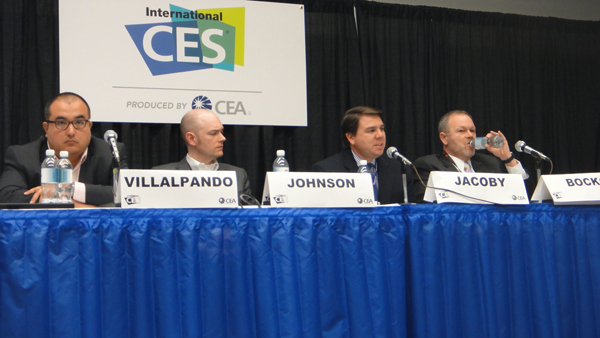What Will Tomorrow’s TV Look Like?
What hardware and services will become dominant in television in the next five or ten years? To explore some possibilities, an opening day CES panel looked for TV's next big thing.
The panel, hosted by Laura Sydell of National Public Radio, brought together a range of hardware and service vendors. Peter Bocko of Corning, which makes the suddenly ubiquitous Gorilla Glass, started things off by addressing the need of TV vendors to find the next big hardware success in order to ship more televisions. While 3D seems to be the obvious answer, he said that many left CES 2010 feeling disappointed by 3D's rollout. The platform has a lot of promise, he said, but got off to a shaky start. Removing the need for 3D glasses would give the platform a big push, he said, but that was still many years away.
In the mean time, TV makers are left to differential their products through design. Most are rushing to a thinner, "monolithic" design, which can lead to a sameness among product lines. Bocko finds that European TV makers are ahead of those in the U.S. at creating interesting TV designs.
Ecological factors are less of a selling point to consumers, but legislation will require future TVs to use less power. Bocko sees plasma sets having a hard time moving to low-power requirements. He also finds that OLED technology has had a tough time emerging in large-scale TVs, but finds that it's a big success in portable TVs.
Connected TV services will play a large role in making TVs more engaging, said Ronald Jacoby, who works with the Yahoo TV service. Yahoo is promoting the second generation of the service at CES this year, offering on-screen elements that deliver more context on a program or ad. Those interactive elements can provide trackable data for advertisers, he said.
Later in the panel, the topic turned to how much information viewers give up when they use connected services and whether TVs watch the viewers watching them. Jacoby maintained that it was important for companies to keep viewer's trust and not abuse their data.
Some of the panel's most interesting moments came from Brian David Johnson, a futurist with Intel Labs. Intel has ethnographers who go into people's homes to watch them watch TV, he explained. They've found that TV isn't TV anymore. Consumers don't break down platforms and content sources in the way that industry insiders do; they just want it all to interconnect and work easily. Johnson thinks of the various options all as "screens," rather than breaking up TVs, tablets, smartphones, and so on by type.

While connected TV services have been slow to take off (Sydell pointed out that most people who own connected TVs aren't using connected services), it's still a new technology, Johnson said. People need time to get used to it. A bigger problem facing the industry is that people's use of new technologies is outpacing what the current infrastructure can deliver.
In order to advance television, the intelligence needs to be removed from the TV and moved to the cloud, asserted Edger Villalpando of Active Video Networks. He company is moving to put all content and services in the cloud, which will drive innovation and make monetizing ads easier.
To the question of whether the client or the cloud is the future of TV, Johnson answered yes. He stated that consumers want choice and that many will want content from both areas. TV is more complicated than simply being a lean back or a lean forward experience, he said.
Related Articles
Connected televisions, which can stream online content with no set-top box required, were one of the hot areas at this year's CES. In this video, a Yahoo! VP explains his company's new interactive features.
10 Jan 2011